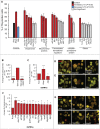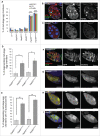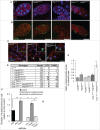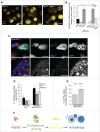Hsp83 loss suppresses proteasomal activity resulting in an upregulation of caspase-dependent compensatory autophagy
- PMID: 28806103
- PMCID: PMC5612217
- DOI: 10.1080/15548627.2017.1339004
Hsp83 loss suppresses proteasomal activity resulting in an upregulation of caspase-dependent compensatory autophagy
Abstract
The 2 main degradative pathways that contribute to proteostasis are the ubiquitin-proteasome system and autophagy but how they are molecularly coordinated is not well understood. Here, we demonstrate an essential role for an effector caspase in the activation of compensatory autophagy when proteasomal activity is compromised. Functional loss of Hsp83, the Drosophila ortholog of human HSP90 (heat shock protein 90), resulted in reduced proteasomal activity and elevated levels of the effector caspase Dcp-1. Surprisingly, genetic analyses showed that the caspase was not required for cell death in this context, but instead was essential for the ensuing compensatory autophagy, female fertility, and organism viability. The zymogen pro-Dcp-1 was found to interact with Hsp83 and undergo proteasomal regulation in an Hsp83-dependent manner. Our work not only reveals unappreciated roles for Hsp83 in proteasomal activity and regulation of Dcp-1, but identifies an effector caspase as a key regulatory factor for sustaining adaptation to cell stress in vivo.
Keywords: Dcp-1; Drosophila; Hsp83; apoptosis; caspase; compensatory autophagy; heat-shock protein; ubiquitin-proteasome system.
Figures






Similar articles
-
Proteasome dysfunction induces excessive proteome instability and loss of mitostasis that can be mitigated by enhancing mitochondrial fusion or autophagy.Autophagy. 2019 Oct;15(10):1757-1773. doi: 10.1080/15548627.2019.1596477. Epub 2019 Apr 19. Autophagy. 2019. PMID: 31002009 Free PMC article.
-
The initiator caspase Dronc is subject of enhanced autophagy upon proteasome impairment in Drosophila.Cell Death Differ. 2016 Sep 1;23(9):1555-64. doi: 10.1038/cdd.2016.40. Epub 2016 Apr 22. Cell Death Differ. 2016. PMID: 27104928 Free PMC article.
-
Thermoprotection of synaptic transmission in a Drosophila heat shock factor mutant is accompanied by increased expression of Hsp83 and DnaJ-1.Physiol Genomics. 2006 May 16;25(3):493-501. doi: 10.1152/physiolgenomics.00195.2005. Epub 2006 Apr 4. Physiol Genomics. 2006. PMID: 16595740
-
Non-apoptotic cell death in animal development.Cell Death Differ. 2017 Aug;24(8):1326-1336. doi: 10.1038/cdd.2017.20. Epub 2017 Feb 17. Cell Death Differ. 2017. PMID: 28211869 Free PMC article. Review.
-
Caspase-dependent cell death in Drosophila.Annu Rev Cell Dev Biol. 2006;22:623-50. doi: 10.1146/annurev.cellbio.21.012804.093845. Annu Rev Cell Dev Biol. 2006. PMID: 16842034 Review.
Cited by
-
The Autophagy-Lysosomal Pathways and Their Emerging Roles in Modulating Proteostasis in Tumors.Cells. 2018 Dec 20;8(1):4. doi: 10.3390/cells8010004. Cells. 2018. PMID: 30577555 Free PMC article. Review.
-
Caspase 3 and caspase 7 promote cytoprotective autophagy and the DNA damage response during non-lethal stress conditions in human breast cancer cells.PLoS Biol. 2025 Feb 21;23(2):e3003034. doi: 10.1371/journal.pbio.3003034. eCollection 2025 Feb. PLoS Biol. 2025. PMID: 39982959 Free PMC article.
-
Elevation of major constitutive heat shock proteins is heat shock factor independent and essential for establishment and growth of Lgl loss and Yorkie gain-mediated tumors in Drosophila.Cell Stress Chaperones. 2022 Jul;27(4):431-448. doi: 10.1007/s12192-022-01283-z. Epub 2022 Jun 15. Cell Stress Chaperones. 2022. PMID: 35704239 Free PMC article.
-
Guidelines for the use and interpretation of assays for monitoring autophagy (4th edition)1.Autophagy. 2021 Jan;17(1):1-382. doi: 10.1080/15548627.2020.1797280. Epub 2021 Feb 8. Autophagy. 2021. PMID: 33634751 Free PMC article.
-
The constructive and destructive impact of autophagy on both genders' reproducibility, a comprehensive review.Autophagy. 2023 Dec;19(12):3033-3061. doi: 10.1080/15548627.2023.2238577. Epub 2023 Jul 28. Autophagy. 2023. PMID: 37505071 Free PMC article. Review.
References
-
- Labbadia J, Morimoto RI. The biology of proteostasis in aging and disease. Annu Rev Biochem 2015; 84:435-64; PMID:25784053; https://doi.org/10.1146/annurev-biochem-060614-033955 - DOI - PMC - PubMed
-
- Ding W-X, Ni HM, Gao W, Yoshimori T, Stolz DB, Ron D, Yin XM. Linking of autophagy to ubiquitin-proteasome system is important for the regulation of endoplasmic reticulum stress and cell viability. Am J Pathol 2007; 171:513-24; PMID:17620365; https://doi.org/10.2353/ajpath.2007.070188 - DOI - PMC - PubMed
-
- Iwata A, Riley BE, Johnston JA, Kopito RR. HDAC6 and microtubules are required for autophagic degradation of aggregated huntingtin. J Biol Chem 2005; 280:40282-92; PMID:16192271; https://doi.org/10.1074/jbc.M508786200 - DOI - PubMed
-
- Lőw P, Varga Á, Pircs K, Nagy P, Szatmári Z, Sass M, Juhász G. Impaired proteasomal degradation enhances autophagy via hypoxia signaling in Drosophila. BMC Cell Biol 2013; 14:29; PMID:23800266; https://doi.org/10.1186/1471-2121-14-29 - DOI - PMC - PubMed
-
- Pandey UB, Nie Z, Batlevi Y, McCray BA, Ritson GP, Nedelsky NB, Schwartz SL, DiProspero NA, Knight MA, Schuldiner O, et al.. HDAC6 rescues neurodegeneration and provides an essential link between autophagy and the UPS. Nature 2007; 447:859-63; PMID:17568747; https://doi.org/10.1038/nature05853 - DOI - PubMed
MeSH terms
Substances
LinkOut - more resources
Full Text Sources
Other Literature Sources
Molecular Biology Databases
Miscellaneous
